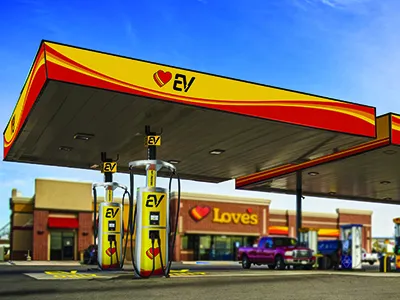- Recent data suggests infrastructure has built out to handle peak EV charging demand
- There are about 50% more charging connectors in 2024 vs. 2023
- Public EV charging is making progress in reliability
U.S. public electric vehicle charging infrastructure kept up with EV sales growth in 2024, and even improved in reliability, a new study indicates.
Conducted by Paren, which provides data services for EV charging, the study looked at end-user experience for fast charging sessions during the Thanksgiving travel week—described as the “Super Bowl of fast charging.”
The study found that the number of charging sessions increased nearly 50% during Thanksgiving week 2024 compared to the same period in 2023. But the number of charging connectors also increased by about the same amount.
The Thanksgiving week served as 2024’s “pressure test” for the charging sector, as it’s when motorists are out on the highways at once in a way that’s not rivaled by any other holiday time—even the Christmas and New Year’s week we’re in now, when travel tends to be spread among many days.

Comparison of Thanksgiving week EV charging sessions and utilization rates (via Paren)
As a result, the average rate of utilization—defined here as a measured of total charging session minutes per connector as a percentage of open hours (typically over a 24-hour period)—declined slightly from 24% to 22%, year-over-year. It shows that infrastructure is keeping up with the increased number of EVs on U.S. roads.
And the number of EVs in the U.S. did indeed increase steadily throughout 2024, with sales up by more than 10% year-over-year in the latter months of the year, and EV market share inching closer to 10% of the overall U.S. light-vehicle market. But 2024 has definitely been a year in which infrastructure gets out ahead of sales growth for EVs—surely a good thing to set the stage for the market. Lack of public chargers was a dealbreaker for nearly half of shoppers in a 2023 J.D. Power survey.
The progress is due in part to lots of filling-in of road-trip fast-charging stations across the nation, allowing far more than the couple of cross-country routes that existed just a few years ago. Electrify America has also tested the idea of limiting fast-charges to 85% at busy stations, and networks seem to be getting smarter about when they need more chargers. For instance, Tesla is adding temporary Superchargers to ease one of the busiest times.

Love’s Travel Stop EV charging
Paren also saw increased reliability, based on the company’s own index that emphasizes the frequency with which drivers are able to successfully initiate and complete charging sessions. This saw an increase of 3.4 percentage points compared to last year, reaching 85.5%. But it’s unclear how much further progress will be made in building out reliable public charging infrastructure over the next few years.
A 2023 Energy Department study suggested that we may need as many as 182,000 publicly-accessible DC fast-charging ports by 2030, to support anywhere from 30-42 million EVs on the roads by then. But given the outcome of the election, it may give infrastructure another chance to work ahead.

